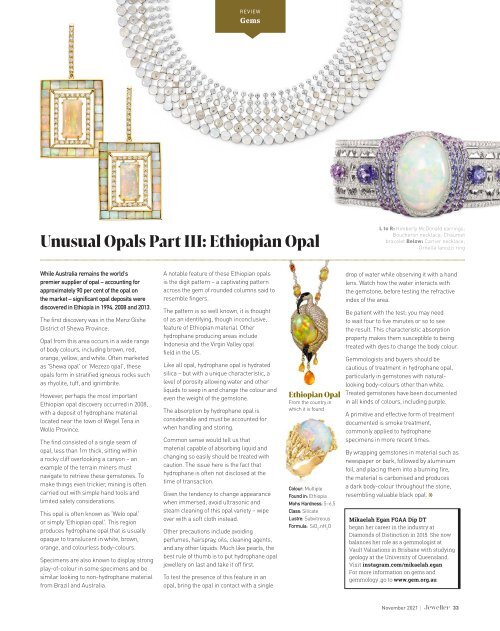Create successful ePaper yourself
Turn your PDF publications into a flip-book with our unique Google optimized e-Paper software.
REVIEW<br />
Gems<br />
Unusual Opals Part III: Ethiopian Opal<br />
L to R: Kimberly McDonald earrings;<br />
Boucheron necklace; Chaumet<br />
bracelet Below: Cartier necklace;<br />
Ornella Ianuzzi ring<br />
While Australia remains the world's<br />
premier supplier of opal – accounting for<br />
approximately 90 per cent of the opal on<br />
the market – significant opal deposits were<br />
discovered in Ethiopia in 1994, 2008 and 2013.<br />
The first discovery was in the Menz Gishe<br />
District of Shewa Province.<br />
Opal from this area occurs in a wide range<br />
of body colours, including brown, red,<br />
orange, yellow, and white. Often marketed<br />
as 'Shewa opal' or 'Mezezo opal', these<br />
opals form in stratified igneous rocks such<br />
as rhyolite, tuff, and ignimbrite.<br />
However, perhaps the most important<br />
Ethiopian opal discovery occurred in 2008,<br />
with a deposit of hydrophane material<br />
located near the town of Wegel Tena in<br />
Wollo Province.<br />
The find consisted of a single seam of<br />
opal, less than 1m thick, sitting within<br />
a rocky cliff overlooking a canyon – an<br />
example of the terrain miners must<br />
navigate to retrieve these gemstones. To<br />
make things even trickier, mining is often<br />
carried out with simple hand tools and<br />
limited safety considerations.<br />
This opal is often known as 'Welo opal'<br />
or simply 'Ethiopian opal'. This region<br />
produces hydrophane opal that is usually<br />
opaque to translucent in white, brown,<br />
orange, and colourless body-colours.<br />
Specimens are also known to display strong<br />
play-of-colour in some specimens and be<br />
similar looking to non-hydrophane material<br />
from Brazil and Australia.<br />
A notable feature of these Ethiopian opals<br />
is the digit pattern – a captivating pattern<br />
across the gem of rounded columns said to<br />
resemble fingers.<br />
The pattern is so well known, it is thought<br />
of as an identifying, though inconclusive,<br />
feature of Ethiopian material. Other<br />
hydrophane producing areas include<br />
Indonesia and the Virgin Valley opal<br />
field in the US.<br />
Like all opal, hydrophane opal is hydrated<br />
silica – but with a unique characteristic, a<br />
level of porosity allowing water and other<br />
liquids to seep in and change the colour and<br />
even the weight of the gemstone.<br />
The absorption by hydrophane opal is<br />
considerable and must be accounted for<br />
when handling and storing.<br />
Common sense would tell us that<br />
material capable of absorbing liquid and<br />
changing so easily should be treated with<br />
caution. The issue here is the fact that<br />
hydrophane is often not disclosed at the<br />
time of transaction.<br />
Given the tendency to change appearance<br />
when immersed, avoid ultrasonic and<br />
steam cleaning of this opal variety – wipe<br />
over with a soft cloth instead.<br />
Other precautions include avoiding<br />
perfumes, hairspray, oils, cleaning agents,<br />
and any other liquids. Much like pearls, the<br />
best rule of thumb is to put hydrophane opal<br />
jewellery on last and take it off first.<br />
To test the presence of this feature in an<br />
opal, bring the opal in contact with a single<br />
Ethiopian Opal<br />
From the country in<br />
which it is found<br />
Colour: Multiple<br />
Found in: Ethiopia<br />
Mohs Hardness: 5–6.5<br />
Class: Silicate<br />
Lustre: Subvitreous<br />
Formula: SiO 2<br />
.nH 2<br />
O<br />
drop of water while observing it with a hand<br />
lens. Watch how the water interacts with<br />
the gemstone, before testing the refractive<br />
index of the area.<br />
Be patient with the test; you may need<br />
to wait four to five minutes or so to see<br />
the result. This characteristic absorption<br />
property makes them susceptible to being<br />
treated with dyes to change the body colour.<br />
Gemmologists and buyers should be<br />
cautious of treatment in hydrophane opal,<br />
particularly in gemstones with naturallooking<br />
body-colours other than white.<br />
Treated gemstones have been documented<br />
in all kinds of colours, including purple.<br />
A primitive and effective form of treatment<br />
documented is smoke treatment,<br />
commonly applied to hydrophane<br />
specimens in more recent times.<br />
By wrapping gemstones in material such as<br />
newspaper or bark, followed by aluminium<br />
foil, and placing them into a burning fire,<br />
the material is carbonised and produces<br />
a dark body-colour throughout the stone,<br />
resembling valuable black opal.<br />
Mikaelah Egan FGAA Dip DT<br />
began her career in the industry at<br />
Diamonds of Distinction in 2015. She now<br />
balances her role as a gemmologist at<br />
Vault Valuations in Brisbane with studying<br />
geology at the University of Queensland.<br />
Visit instagram.com/mikaelah.egan<br />
For more information on gems and<br />
gemmology ,go to www.gem.org.au<br />
<strong>November</strong> <strong>2021</strong> | 33


















